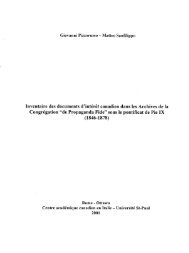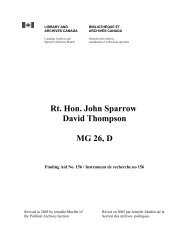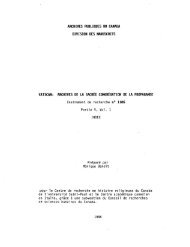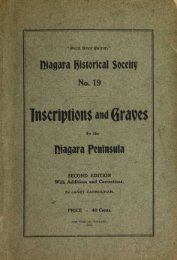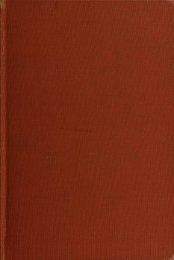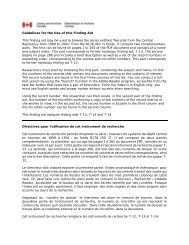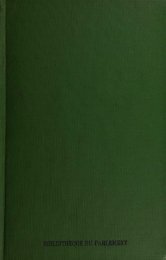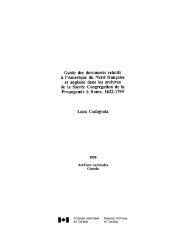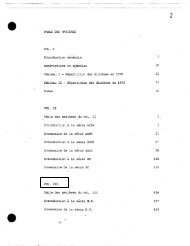Guide to Documents Relating to French and British North America in ...
Guide to Documents Relating to French and British North America in ...
Guide to Documents Relating to French and British North America in ...
Create successful ePaper yourself
Turn your PDF publications into a flip-book with our unique Google optimized e-Paper software.
Propag<strong>and</strong>a, however, added that "Sua Santita non avra difficolta di deputare per vicario apos<strong>to</strong>lico 10<br />
stesso ecclesiastico elet<strong>to</strong> per vescovo di quel capi<strong>to</strong>lo."s3 [See Appendix A for translation.] A few<br />
years later, at the beg<strong>in</strong>n<strong>in</strong>g of the <strong>America</strong>n War of <strong>America</strong>n Independence, Propag<strong>and</strong>a was not<br />
disturbed by the fact that this was, after all, a revolution aga<strong>in</strong>st an established authority. It waited <strong>to</strong><br />
see who would come out the w<strong>in</strong>ner, <strong>and</strong> then it came <strong>to</strong> terms with the representatives of the<br />
<strong>America</strong>n Congress, manag<strong>in</strong>g <strong>to</strong> conv<strong>in</strong>ce the new rulers <strong>to</strong> accept the establishment of a Catholic<br />
hierarchy <strong>in</strong> the United States. 54<br />
It would be a mistake <strong>to</strong> consider this unchang<strong>in</strong>g work<strong>in</strong>g style of Propag<strong>and</strong>a <strong>and</strong> the<br />
uniformity of its decisions as evidence that Propag<strong>and</strong>a was not affected by the general shift <strong>in</strong> the<br />
European perception of the New World. Th<strong>in</strong>gs did <strong>in</strong>deed change, even for Propag<strong>and</strong>a officials. Over<br />
the decades, a new geographical awareness slowly replaced the confusion <strong>North</strong> <strong>America</strong> had caused<br />
<strong>to</strong> the early officials of the Congregation. In the l620s they had been unable <strong>to</strong> locate Lord Baltimore's<br />
colony of Avalon on the isl<strong>and</strong> of Newfoundl<strong>and</strong>, which was probably the portion of <strong>North</strong> <strong>America</strong><br />
best known <strong>to</strong> early seventeenth-century Europeans. ss They appo<strong>in</strong>ted Pacifique de Prov<strong>in</strong>s prefect of<br />
the missions of Canada (i.e., Acadia), <strong>and</strong> cont<strong>in</strong>ued <strong>to</strong> style him with that title even though he never<br />
went <strong>to</strong> <strong>North</strong> <strong>America</strong> <strong>and</strong> spent most of his <strong>America</strong>n life <strong>in</strong> the West Indies. 56 They suggested that<br />
a mission <strong>in</strong> Guyana could make it possible <strong>to</strong> f<strong>in</strong>d an overl<strong>and</strong> passage through <strong>North</strong> <strong>America</strong> lead<strong>in</strong>g<br />
<strong>to</strong> the Indians of New Mexico. 57 R<strong>and</strong>om mistakes of this k<strong>in</strong>d became less <strong>and</strong> less frequent <strong>in</strong> the<br />
second half of the seventeenth century, <strong>and</strong> were virtually non-existent <strong>in</strong> the eighteenth century.<br />
Marg<strong>in</strong>al notes, which served the purpose o~ identify<strong>in</strong>g the geographical location of a document,<br />
became more precise, although there was still room for confusion. "Canada" became "Quebec" after<br />
the erection of the bishopric, <strong>and</strong> reverted <strong>to</strong> "Canada" <strong>in</strong> the late eighteenth century. The <strong>British</strong><br />
cont<strong>in</strong>ental colonies were always "Indie Occidentali" (<strong>and</strong> as such were often confused with the isl<strong>and</strong>s<br />
proper), until they were referred <strong>to</strong> as "Baltimore" on account of the new bishopric. "<strong>America</strong>" usually<br />
meant Spanish or Portuguese <strong>America</strong>, while Newfoundl<strong>and</strong> was simply "Terranova." Sa<strong>in</strong>t-Pierre <strong>and</strong><br />
Miquelon were a special case, as they are <strong>to</strong>day. S<strong>in</strong>ce they were isl<strong>and</strong>s, they were usually <strong>in</strong>cluded<br />
with the West Indies, although it was evident that they were far away from the Caribbean seas.58<br />
In view of what was happen<strong>in</strong>g elsewhere <strong>in</strong> the world, it is not surpris<strong>in</strong>g that this shift <strong>in</strong><br />
perception became more evident <strong>in</strong> the second half of the eighteenth century, as shown by the sheer<br />
quantity of <strong>North</strong> <strong>America</strong>n material received by Propag<strong>and</strong>a from the early l760s onwards. From the<br />
end of the Seven Years War the amount of mail <strong>in</strong>creased out of all proportions <strong>to</strong> the previous period.<br />
It is worth not<strong>in</strong>g, for example, that a third (33.5%) of the 460 letters of <strong>North</strong> <strong>America</strong>n <strong>in</strong>terest<br />
written by Propag<strong>and</strong>a over the 177 years between 1622 <strong>and</strong> 1790 are dated between 1622 <strong>and</strong> 1759,<br />
while the other two thirds (66.5%) were sent between 1760 <strong>and</strong> 1799. Correspondence with the bishops<br />
of Quebec (Bri<strong>and</strong>, d'Esgly, Jean-Fran~ois Hubert, Pierre Denaut) became a regular duty for Propag<strong>and</strong>a<br />
officials. Even more time-consum<strong>in</strong>g was Propag<strong>and</strong>a's correspondence with the bishop of Quebec's<br />
vicar general <strong>in</strong> Paris, the Abbe de L'Isle-Dieu, whose passion for letter-writ<strong>in</strong>g was almost matched<br />
by his successor, Villars. After Carroll's appo<strong>in</strong>tment as prefect apos<strong>to</strong>lic of the missions <strong>in</strong> the United<br />
Prov<strong>in</strong>ces of <strong>America</strong>, Propag<strong>and</strong>a began a regular correspondence not only with the future bishop, but<br />
also with a number of his <strong>America</strong>n confreres who had been <strong>in</strong> hid<strong>in</strong>g most of their lives <strong>and</strong> wanted<br />
<strong>to</strong> profit from the new climate of religious <strong>to</strong>lerance. On some matters relat<strong>in</strong>g <strong>to</strong> <strong>North</strong> <strong>America</strong>,<br />
Propag<strong>and</strong>a prepared detailed dossiers for the use of the secretary -- a small change from previous<br />
work<strong>in</strong>g practices that can be <strong>in</strong>terpreted as a new awareness of the importance of <strong>America</strong>n events. S9<br />
At the same time, new open<strong>in</strong>gs for missions were found <strong>in</strong> Newfoundl<strong>and</strong>, <strong>in</strong> Sa<strong>in</strong>t-Pierre <strong>and</strong><br />
Miquelon, <strong>in</strong> the Canadian <strong>North</strong>west, among the Iroquois, <strong>and</strong> along the Ohio River. 60<br />
In the second half of the eighteenth century, a better knowledge of <strong>North</strong> <strong>America</strong>n events<br />
accompanied Propag<strong>and</strong>a's <strong>in</strong>creas<strong>in</strong>g awareness of the geography of the New World. The <strong>in</strong>struction<br />
sent <strong>to</strong> Pietro Pamphili Colonna, archbishop of Colossus <strong>and</strong> nuncio <strong>in</strong> France, on 28 March 1764, well<br />
described the state of the <strong>French</strong> colonies of <strong>America</strong> after the Conquest <strong>and</strong> the political strategy <strong>to</strong><br />
10




